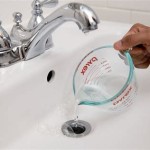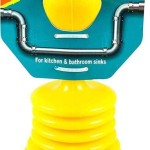Wall Mount Powder Room Sink: A Space-Saving Solution for Small Bathrooms
The powder room, often the smallest bathroom in a house, typically contains only a toilet and a sink. Optimizing space in this compact area is paramount for functionality and aesthetics. One effective strategy for maximizing square footage in a powder room is the installation of a wall mount sink. These sinks, also known as floating sinks, are affixed directly to the wall, eliminating the need for a traditional vanity or pedestal base. This design creates the illusion of more space, simplifies cleaning, and can contribute to a modern, minimalist aesthetic.
Selecting the right wall mount sink for a powder room involves considering several factors, including size, material, style, installation requirements, and plumbing considerations. A thorough understanding of these aspects is crucial to ensure a successful and satisfying outcome.
Space Optimization and Accessibility
The most significant advantage of a wall mount sink is its ability to free up floor space. In a small powder room, even a few extra inches can make a noticeable difference. By removing the bulky base of a standard vanity, a wall mount sink allows for easier maneuverability and a less cluttered appearance. The open space underneath the sink can also be utilized for storing small items, such as decorative baskets or rolled towels, although it's important to maintain a clean and uncluttered look to preserve the feeling of spaciousness.
Furthermore, wall-mounted sinks can be installed at varying heights, catering to the specific needs of the user. This adaptability makes them a particularly suitable option for individuals with mobility issues or those who prefer a higher or lower sink height for ergonomic reasons. Careful consideration should be given to the recommended mounting height, typically around 31 to 36 inches, to ensure comfortable use for most individuals. However, adjustments can be made based on the average height of the household members or accessibility requirements.
The lack of a base also simplifies cleaning. With no corners or crevices around the floor, it becomes much easier to sweep, mop, or vacuum the entire floor area. This is a significant advantage in a high-traffic area like a powder room, where cleanliness is of utmost importance.
Material Choices and Aesthetic Considerations
Wall mount powder room sinks are available in a wide range of materials, each offering different aesthetic qualities and performance characteristics. Common material choices include:
*Vitreous China:
This is a popular and affordable option known for its durability, stain resistance, and ease of cleaning. Vitreous china sinks are typically coated with a glossy finish, providing a clean and classic look. *Porcelain:
Similar to vitreous china, porcelain is a durable and non-porous material that is resistant to scratches and stains. Porcelain sinks often come in a wider variety of colors and styles compared to vitreous china. *Glass:
Glass sinks offer a sleek and modern aesthetic. They can be clear, frosted, or tinted, and are available in various shapes and sizes. While visually appealing, glass sinks require more frequent cleaning to maintain their pristine appearance and can be susceptible to scratches. *Stainless Steel:
Stainless steel sinks are durable, hygienic, and resistant to corrosion. They offer a modern, industrial look and are often used in contemporary bathroom designs. *Stone (Granite, Marble, Travertine):
Stone sinks provide a luxurious and natural aesthetic. They are durable and unique, with each sink exhibiting variations in color and veining. Stone sinks require special care and maintenance to prevent staining and etching. *Concrete:
Concrete sinks are increasingly popular in modern and industrial-style bathrooms. They offer a unique texture and can be customized with different colors and finishes. Concrete sinks require sealing to protect them from water damage.The choice of material should complement the overall design of the powder room. For instance, a vitreous china or porcelain sink would be suitable for a traditional or classic bathroom, while a glass or stainless steel sink would be a better choice for a modern or contemporary space. Stone or concrete sinks can add a touch of luxury and sophistication to any powder room.
Beyond the material, the style of the sink itself is crucial. Wall-mounted sinks come in various shapes, including rectangular, oval, round, and asymmetrical designs. The shape of the sink should be proportional to the size of the powder room and complement the overall aesthetic. A small, round sink might be ideal for a very small space, while a larger, rectangular sink could be suitable for a slightly larger powder room.
The finish of the sink and the accompanying hardware (faucets, drains, and traps) should also be carefully considered. Coordinating the finishes will create a cohesive and polished look. Common finish options include chrome, brushed nickel, oil-rubbed bronze, and matte black.
Installation Requirements and Plumbing Considerations
Installing a wall mount sink involves several key steps, including ensuring adequate wall support, connecting the plumbing, and properly sealing the sink to the wall. It is generally recommended to consult with a qualified plumber or contractor to ensure a safe and professional installation.
Wall Support:
Wall-mounted sinks are supported directly by the wall, making it crucial to ensure that the wall is strong enough to bear the weight of the sink and any additional weight placed on it. Ideally, the sink should be mounted to studs or a reinforced backing within the wall. If the wall is not structurally sound, it may be necessary to reinforce it before installing the sink.Plumbing Connections:
The plumbing connections for a wall mount sink are typically concealed within the wall. This requires careful planning and execution to ensure that the water supply lines and drainpipe are properly positioned and connected. The drainpipe must be properly vented to prevent sewer gases from entering the bathroom.Trap and Waste Arm:
A P-trap is an essential component of the drain system that prevents sewer gases from entering the bathroom. The trap should be installed according to local plumbing codes. The waste arm connects the trap to the drainpipe within the wall.Faucet Selection:
The faucet selection is another important consideration. Wall-mounted faucets are a popular choice for wall mount sinks, as they further enhance the clean and minimalist appearance of the installation. However, deck-mounted faucets can also be used if the sink is designed with pre-drilled holes.Sealing:
Proper sealing between the sink and the wall is essential to prevent water damage. A high-quality sealant, such as silicone caulk, should be applied to all edges of the sink where it meets the wall.During the installation process, it's crucial to adhere to all local plumbing codes and regulations. These codes are designed to ensure the safety and functionality of the plumbing system and to prevent potential problems such as leaks, water damage, and sewer gas intrusion. Failure to comply with these codes can result in costly repairs and potential health hazards.
Prior to installation, it is advisable to create a detailed plan that includes the sink's dimensions, mounting height, plumbing connections, and faucet selection. This plan will help to ensure that the installation process goes smoothly and that the finished result meets the desired specifications.
Moreover, consider the placement of electrical outlets in relation to the sink. Electrical outlets should be located at a safe distance from the sink to prevent the risk of electric shock. If necessary, consult with a qualified electrician to ensure that the electrical wiring is properly installed and grounded.
Finally, remember to thoroughly inspect the sink for any defects or damage before beginning the installation. If any problems are detected, contact the manufacturer or retailer for a replacement or refund.
By carefully considering these factors and working with qualified professionals, homeowners can successfully install a wall mount sink in their powder room and enjoy the benefits of space optimization, accessibility, and aesthetic appeal.

Powder Room With Wall Mount Concrete Sink Vanity Traditional Bathroom

Wall Mount Sinks Mounted Bathroom Signature Hardware

Wall Mounted Powder Room Sink Design Ideas

Renovators Supply Manufacturing Ridge White Ceramic Small Wall Mounted Bathroom Sink With Brass Faucet Drain Towel Bar And Overflow 33337 The Home

Light Veined White Marble Sink With Backsplash Bathroom Wall Mounted Vanity Top Carrara Powder Room Etsy

Powder Room With Gray Concrete Wall Mount Sink Transitional Bathroom

Higgins 24 Wall Mount Powder Sink Rejuvenation

Browse Wall Mounted Basins Hung Bathware Direct

These 20 Small Bathroom Decorating Ideas Deliver Big Impact

Nantucket Sinks 20 Wall Mount Utility Or Bathroom Sink With Overflow







